How Much Is It To Replace A Iphone 11 Screen




-
Before you begin, discharge your iPhone battery below 25%. A charged lithium-ion battery can catch fire and/or explode if accidentally punctured.
-
Power off your iPhone before beginning disassembly.
-
Remove the two 6.7 mm-long pentalobe screws at the bottom edge of the iPhone.
-
Opening the iPhone's display will compromise its waterproof seals. Have replacement seals ready before you proceed past this step, or take care to avoid liquid exposure if you reassemble your iPhone without replacing the seals.



-
If your iPhone has a cracked screen, keep further breakage contained and prevent bodily harm during your repair by taping over the glass.
-
Lay overlapping strips of packing tape over the iPhone's display until the whole face is covered.
-
This will keep glass shards contained and provide structural integrity when prying and lifting the display.
-
Wear safety glasses to protect your eyes from any glass shaken free during the repair.
-
If the broken glass makes it difficult to get a suction cup to stick in the next few steps, try folding a strong piece of tape (such as duct tape) into a handle and lifting the display with that instead.

-
Heating the lower edge of the iPhone helps soften the adhesive securing the display, making it easier to open.
-
Use a hairdryer or heat gun or prepare an iOpener and apply it to the lower edge of the iPhone for about a minute.




-
The next two steps demonstrate the iSclack, a handy tool that we recommend for anyone doing frequent repairs. If you aren't using the iSclack, skip down two steps for an alternate method.
-
If the plastic depth gauge is attached at the center of the iSclack, remove it now—it's not needed for larger iPhones like the iPhone 11.
-
Position the suction cups near the bottom edge of the iPhone—one on the front, and one on the back.
-
Press both suction cups firmly into place.
-
If your display or back glass is badly cracked, covering it with a layer of clear packing tape may help the suction cups adhere. The iSclack also includes two pieces of tape for this purpose.
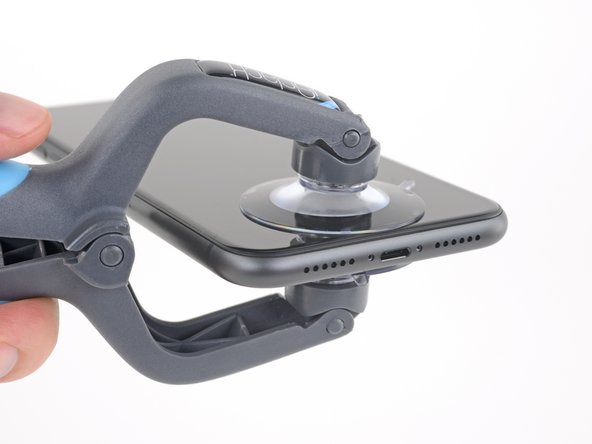


-
Hold onto your iPhone securely and close the handle of the iSclack to slightly separate the screen from the rear case of the phone.
-
Don't try to completely separate the screen; a small opening along the bottom edge is all you need.
-
Insert an opening pick into the gap under the display on the lower edge of the iPhone.
-
Skip the next two steps.




-
If you're using a single suction handle, apply it to the bottom edge of the phone, while avoiding the curved portion of the glass.
-
If your display is badly cracked, covering it with a layer of clear packing tape may help the suction cup to stick. Alternatively, you can use very sticky tape instead of the suction cup. Or if all else fails, you can superglue the suction cup to the broken screen.



-
Pull up on the suction cup with firm, constant pressure to create a slight gap between the front panel and rear case.
-
Insert an opening pick into the gap.
-
The watertight adhesive holding the display in place is very strong; creating this initial gap takes a significant amount of force. If you're having a hard time opening a gap, apply more heat, and gently rock the screen up and down to weaken the adhesive until you create enough of a gap to insert your tool.



-
Slide the opening pick around the lower left corner and up the left edge of the iPhone, slicing through the adhesive holding the display in place.
-
Don't insert the opening pick too far into the iPhone, or you may cause damage to internal components.



-
Re-insert your pick at the bottom edge of the iPhone, and slide it up the right side to continue separating the adhesive.
-
Don't insert the pick very far, or you may damage the display cables along this side of the iPhone. Insert it only a few millimeters, or about the width of the display bezel.



-
The top edge of the display is secured with both glue and clips.
-
Gently pull the right edge of the display down slightly (in the direction of the Lightning port).
-
Insert your pick into the top-right corner of the phone.




-
Continue pulling the display down (toward the Lightning port) as needed in order to make a gap large enough for the pick.
-
Slide the pick to the top left corner and cut any remaining adhesive securing the display.
-
Again, don't insert the pick more than a few millimeters—about the width of the display bezel—or you may damage the Face ID sensor array.

-
Pull the small nub on the suction cup to detach it from the front panel.
-
If you used an iSclack and it's still affixed to the iPhone, remove it now.



-
Open the iPhone by swinging the display up from the left side, like the back cover of a book.
-
Don't try to fully separate the display yet, as several fragile ribbon cables still connect it to the iPhone's logic board.
-
Prop the display up against something sturdy.
-
During reassembly, lay the display in position, align the clips along the top edge, and carefully press the top edge into place before snapping the rest of the display down. If it doesn't click easily into place, check the condition of the clips around the perimeter of the display and make sure they aren't bent.




-
To access the screws in the following step, tilt the display by slightly lifting its lower edge.
-
Be careful not to strain or tear the display cables.


-
Use a Y000 driver to remove the three 1.1 mm-long screws securing the battery connector bracket.
-
Throughout this repair, keep track of each screw and make sure it goes back exactly where it came from.
-
During reassembly, this is a good point to power on your iPhone and test all functions before you seal the display in place. Be sure to power your iPhone back down completely before you continue working.

-
Remove the bracket.




-
Use a spudger or a clean fingernail to pry the battery connector up from its socket on the logic board.
-
Try not to damage the black silicone seal surrounding this and other board connections. These seals provide extra protection against water and dust intrusion.
-
Bend the connector slightly away from the logic board to prevent it from accidentally contacting the socket.




-
Use a Y000 driver to remove the five 1.1 mm screws securing the logic board cover bracket.

-
Remove the bracket.



-
Use a spudger or a fingernail to disconnect the LCD panel cable connector.
-
Disconnect the digitizer connector next to it.




-
Use the point of a spudger or a fingernail to disconnect the front panel sensor assembly connector.

-
Remove the display assembly.
-
During reassembly, pause here if you wish to replace the waterproof adhesive around the edges of the display.

-
Remove four screws securing the speaker/sensor assembly:
-
Three 1.6 mm Phillips screws
-
One 1.3 mm Y000 screw



-
Use the point of a spudger to gently pry up the top edge of the speaker.
-
Flip the speaker assembly over—down and away from the top edge of the display.
-
The speaker remains attached via very thin ribbon cables. Be careful not to strain or damage the cables.

-
Use a hairdryer or heat gun or prepare an iOpener and apply it to the top front of the display for 1-2 minutes, in order to soften the adhesive securing the sensors.



-
Carefully slide the edge of your opening pick underneath the flex cable below the microphone.
-
Twist gently to separate the microphone, while being careful not to strain or damage the flex cable.
-
If needed, use the point of the spudger to finish separating the microphone from its notch in the front panel.




-
Use tweezers to slide the small bracket straight up and off of the ambient light sensor.




-
Use tweezers to wiggle the ambient light sensor and lift it from its notch in the display.
-
If the sensor does not wiggle free after a few seconds, apply more heat and try again.
-
The sensor remains attached to the rest of the sensor assembly via a very thin flex cable. Be careful not to strain or damage the cable.



-
Working left to right, slide an opening pick beneath the flex cable and underneath the proximity sensor + flood illuminator module.
-
Gently wiggle and lift to separate the module from its notch in the front panel.
-
It's helpful to lift and hold the speaker out of the way for access. Just be careful not to pull on the thin flex cable while you work.



-
Remove the earpiece speaker and front sensor assembly.
-
During reassembly, check the position of the black plastic module containing these components:
-
Proximity sensor
-
Flood illuminator
-
The module must be positioned so that these components are not obstructed by any adhesive.

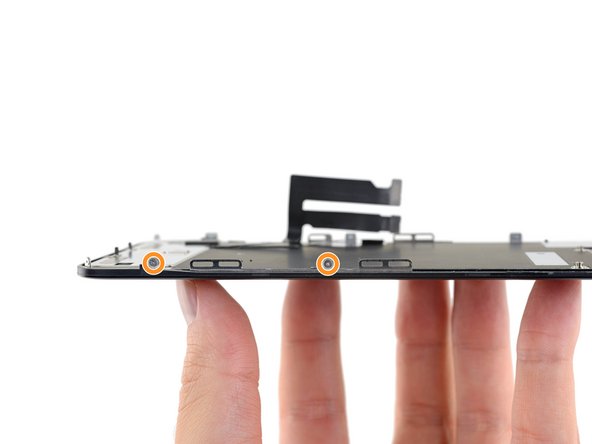

-
Use a Y000 driver to remove the 1.1 mm screws securing the LCD shield:
-
Three screws on the side nearest the display cables
-
Two more screws on the opposite side
-
Press your driver firmly into the screw while turning it. If needed, you can use your spudger to brace each screw from behind, in order to apply more pressure to the screws without bending the shield.

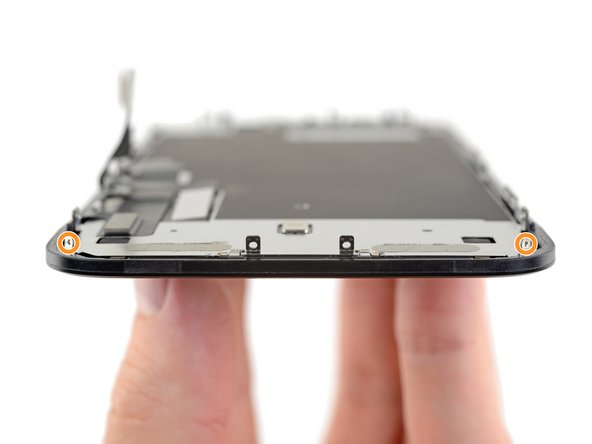


-
Remove the remaining 1.1 mm Y000 screws from the top and bottom edges of the LCD shield:
-
Two screws near the camera cutouts
-
Two screws at the bottom corners




-
Apply a little heat from an iOpener (or hair dryer / heat gun) to the back of the display, in order to soften the adhesive securing the display cables to the LCD shield.




-
Insert an opening pick between the display cables and LCD shield.
-
Slide it toward the bottom edge of the display to begin separating the cables.
-
Stop when you reach the end of the first cable.

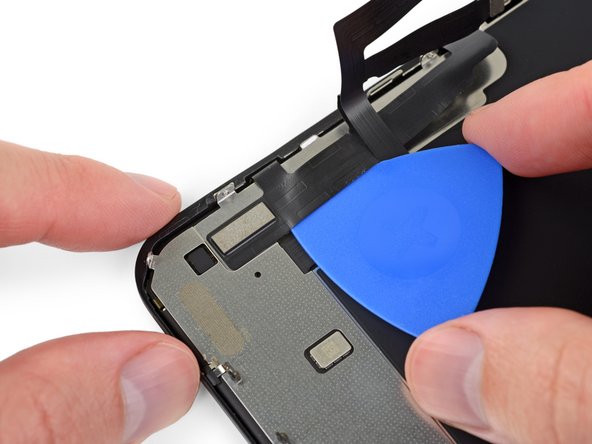
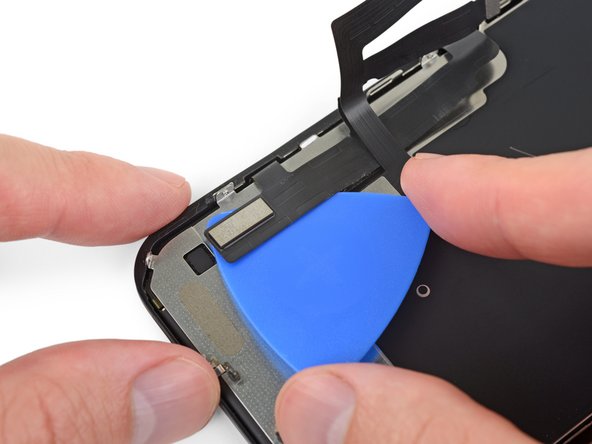
-
Re-insert your opening pick, this time between the two cables.
-
Slide the pick to the bottom edge of the display to separate the cables from each other.




-
Grab each cable near its 90° bend, and peel them apart.




-
Peel the entire digitizer cable away from the LCD shield, and fold it aside.




-
Insert an opening pick under the top edge of the LCD shield, and twist to separate it from the display.




-
Grab the LCD shield by its top edge and swing it upward a few degrees.
-
Using your spudger, press gently on the lower part of the display cable, pushing it through the cutout in the LCD shield.



-
Raise the top edge of the LCD shield a bit higher, and feed the rest of the display cable through the cutout in the shield.



-
Raise the LCD shield up at a higher angle, until you can see the rest of the display cable stuck to the back.
-
Slide a spudger between the LCD shield and the display cable, and separate them completely.


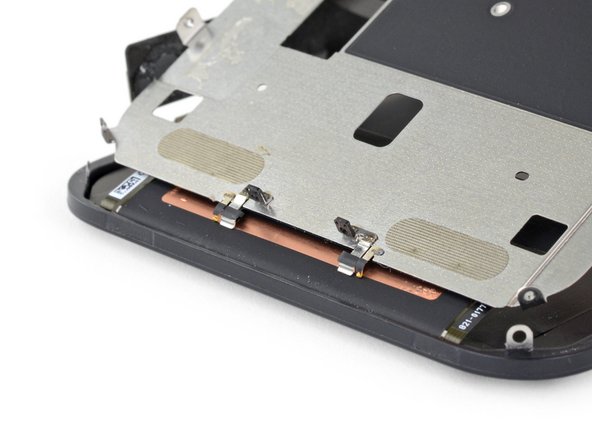
-
As you lift the LCD shield, note the metal prongs on the bottom edge.
-
During reassembly, make sure these prongs (a.k.a. EMI fingers) are correctly inserted into the LCD frame as shown.

-
Remove the LCD shield.

-
Only the LCD and digitizer remains.
How Much Is It To Replace A Iphone 11 Screen
Source: https://www.ifixit.com/Guide/iPhone+11+Screen+Replacement/126236
Posted by: irishdientiong.blogspot.com

0 Response to "How Much Is It To Replace A Iphone 11 Screen"
Post a Comment